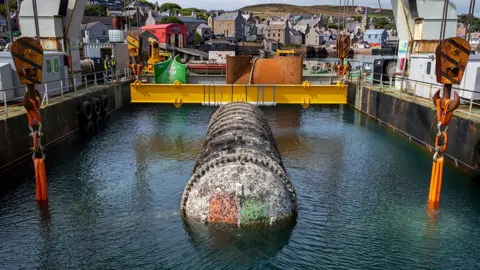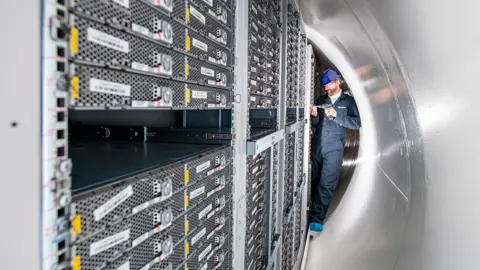Microsoft's underwater data centre resurfaces after two years

 Microsoft
MicrosoftTwo years ago, Microsoft sank a data centre off the coast of Orkney in a wild experiment.
That data centre has now been retrieved from the ocean floor, and Microsoft researchers are assessing how it has performed, and what they can learn from it about energy efficiency.
No humans, few failures
Their first conclusion is that the cylinder packed with servers had a lower failure rate than a conventional data centre.
When the container was hauled off the seabed around half a mile offshore after being placed there in May 2018, just eight out of the 855 servers on board had failed.
That compares very well with a conventional data centre.
"Our failure rate in the water is one-eighth of what we see on land," says Ben Cutler, who has led what Microsoft calls Project Natick.
The team is speculating that the greater reliability may be connected to the fact that there were no humans on board, and that nitrogen rather than oxygen was pumped into the capsule.
 Microsoft
Microsoft"We think it has to do with this nitrogen atmosphere that reduces corrosion and is cool, and people not banging things around," Mr Cutler says.
Orkney was chosen for the trial by Microsoft, partly because it was a centre for renewable energy research in a place where the climate was temperate - perhaps even chilly. The idea was that the cost of cooling computers would be lower if they were under water.
The white cylinder emerged from the cold waters with a coating of algae, barnacles and sea anemones after a day-long operation. But inside, the data centre was functioning well - and is now being closely examined so that the research team can learn more.
As more and more of our data is stored in the cloud, there is growing concern about the vast energy demands of data centres.
Reliably green
Project Natick was partly about working out whether clusters of small underwater data centres for short-term use might be a commercial proposition, but also an attempt to learn broader lessons about energy efficiency in cloud computing.
Around 70 percent of Orkney's electricity comes from wind and solar power, but there were no issues in keeping the underwater data centre supplied with power.
"We have been able to run really well on what most land-based data centres consider an unreliable grid," says Spencer Fowers, one of the technical team on Project Natick.
"We are hopeful that we can look at our findings and say maybe we don't need to have quite as much infrastructure focused on power and reliability."
 Microsoft
MicrosoftUnderwater data centres might sound an outlandish idea. But David Ross, who has been a consultant to the data centre industry for many years, says the project has great potential.
He believes organisations facing a natural disaster or a terrorist attack might find it attractive: "You could effectively move something to a more secure location without having all the huge infrastructure costs of constructing a building. It's flexible and cost effective."
Microsoft is cautious about saying when an underwater data centre might be a commercial product, but is confident that it has proved the idea has value.
"We think that we're past the point where this is a science experiment," says Ben Cutler.
"Now it's simply a question of what do we want to engineer - would it be a little one, or would it be a large one?"
The experiment on Orkney is over. But the hope is that the result will be more environmentally friendly data storage, both on land and under water.
Clarification January 6, 2023: This article was edited to reflect that not all of Orkney's electricity comes from wind and solar generation. Over the course of last year around 30% of Orkney's electricity was received from the mainland.
